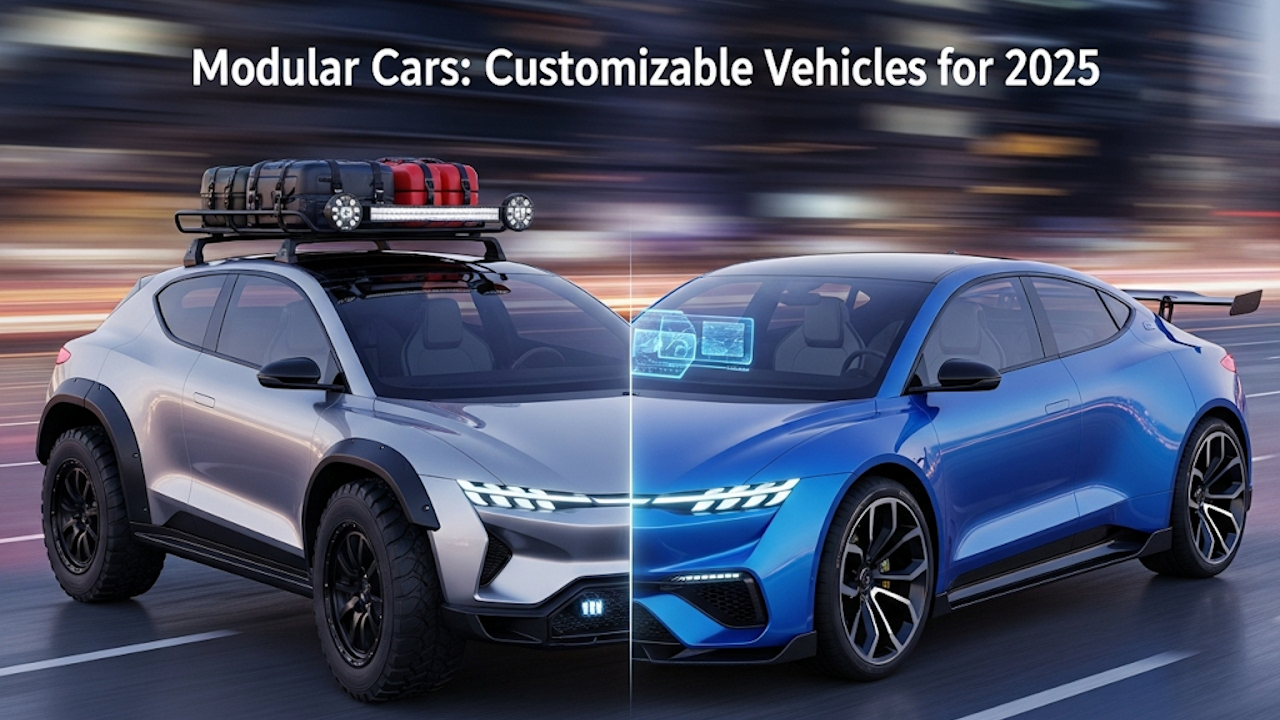The automotive industry is at a turning point in 2025. Sustainability, personalization, and rapid technological change are reshaping how cars are designed, built, and sold. One of the most promising innovations in this space is the concept of modular cars. These are vehicles that can be customized, upgraded, and even reconfigured based on the needs of the driver. Instead of being locked into one fixed design, modular cars promise flexibility, efficiency, and individuality.
What Are Modular Cars?
A modular car is built from interchangeable parts or modules that can be easily swapped out. Think of it as a vehicle made of building blocks rather than one continuous structure. Core modules might include the chassis, battery, powertrain, and interior components, while optional modules could cover exterior panels, entertainment systems, or advanced driver assistance features.
This approach allows drivers to update their cars without buying an entirely new model. For example, someone could upgrade to a larger battery pack for longer trips, switch to sportier suspension for performance driving, or replace panels for a fresh look.
Drivers of the Modular Trend
Several factors are pushing the automotive industry toward modularity in 2025.
- Sustainability
Traditional cars have short life cycles, often becoming outdated within a decade. Modular designs extend vehicle lifespans by allowing parts to be replaced instead of the whole car. This reduces waste, lowers resource consumption, and fits well into circular economy models. - Cost Efficiency
For consumers, replacing individual modules can be much cheaper than buying a new car. For automakers, producing standardized modules at scale reduces manufacturing complexity and costs. - Personalization
Modern buyers want products that reflect their identity. Modular cars let customers tailor vehicles to specific lifestyles, whether for commuting, off-roading, family trips, or city driving. - Technological Evolution
With rapid advances in batteries, sensors, and software, cars risk becoming obsolete quickly. Modular systems make upgrades seamless, letting owners keep up with innovation without starting from scratch.
Key Features of Modular Cars in 2025
Several automakers and startups are experimenting with modular vehicles, and their designs share common characteristics.
- Swappable Batteries: Electric modular cars often feature removable battery packs. This allows quick replacement at charging stations, longer driving ranges when needed, or recycling of old packs.
- Customizable Interiors: Seats, dashboards, and storage can be rearranged to suit different purposes. A family might choose a spacious cabin configuration, while a solo driver might opt for minimalist comfort.
- Exterior Panels: Some concepts allow owners to change body panels for aesthetic updates. Instead of trading in a car for a new design, a driver can simply update the exterior styling.
- Upgradable Software and Hardware: Modular systems extend beyond physical components. Infotainment systems, driver assistance features, and safety tools can be upgraded through software patches or hardware swaps.
Examples of Modular Innovation
In 2025, several prototypes and early models demonstrate the power of modular design.
- EV Startups: Young companies are exploring modular electric vans for urban deliveries. Fleets can expand capacity by adding battery packs or switching cargo modules for passenger transport.
- Major Automakers: Established brands are offering vehicles built on modular electric platforms. While the chassis remains standard, options for size, body style, and power levels allow for efficient mass production and consumer choice.
- Car-Sharing Services: Mobility companies are adopting modular designs to adapt fleets for changing demand. A vehicle might serve as a delivery van during the day and a ride-share car at night by swapping interior modules.
Benefits for Consumers
For everyday drivers, modular cars could change how people think about ownership. Instead of committing to a single style of vehicle for years, drivers can adapt as their lives evolve. A compact city car could be reconfigured into a larger family vehicle. Someone focused on sustainability could choose lighter materials and smaller batteries for daily use, then rent larger modules for occasional long trips.
The flexibility also reduces the financial pressure of buying a new car. Rather than trading in for a newer model, customers could spread costs across smaller upgrades over time.
Challenges and Limitations
Despite the promise, modular cars face several challenges in 2025.
- Standardization: For the system to work, modules must be compatible across models or even brands. Without common standards, modularity could remain niche.
- Safety Regulations: Swappable parts must meet strict safety requirements, which adds complexity. Regulators will need to adapt to ensure safety without stifling innovation.
- Durability: Frequent swapping of modules could lead to wear and reduced reliability if not designed properly.
- Market Adoption: Consumers may hesitate to embrace modularity until proven reliable and cost-effective. Changing cultural attitudes toward car ownership will take time.
The Road Ahead
In 2025, modular cars are still in their early stages, but momentum is building. Automakers recognize the growing demand for sustainability and flexibility, while governments support designs that reduce waste. If standardization and reliability issues are solved, modular cars could become a mainstream option within the next decade.
This shift may also reshape the auto industry. Dealerships could transition into service hubs that specialize in upgrading, maintaining, and swapping modules. Car ownership may look more like a subscription service, where drivers pick and choose modules for different needs.
Conclusion
Modular cars represent a bold step toward a future of adaptable, sustainable, and personalized vehicles. By 2025, the idea has moved from concept to reality, with early models showing both promise and challenges. If the industry can overcome hurdles of regulation, compatibility, and consumer trust, modular vehicles could redefine mobility. Rather than buying a car that grows outdated in a few years, drivers may soon own vehicles that evolve with them, one module at a time.

